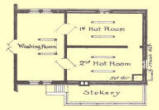The company's working horses
It has been estimated that in 1893 there were about 300,000 working horses in London.1 An article (in the July 1900 number of the Railway Magazine by George Wade) indicated that at King's Cross Station, London terminus of the Great Northern Railway, up to 1,000 heavy horses would be working at the same time. Another 300 would be off-duty2 and resting in the stables which had been built under the goods platform.3 A further 185 horses worked in the passenger parcels department and 40 in railway omnibus duties and in the adjoining yard.1
The horses, which cost about £60 each, worked twelve hours per day for four days per week if they were trotting horses, or five days per week if they were walking horses. The working life of a Great Northern horse was about four years. If all the horses working in the company's other stations and goods depots are taken into consideration it is clear that much time and money was spent in housing and feeding them.
The Turkish baths
In 1884, the Great Northern Railway opened its hospital for horses which included a complete Turkish baths suite comprising three interconnected rooms.
 First, a large wash room or grooming room [supplied with hot and cold water], from which is entered the first hot room or
tepidarium, from 140°F to 150°F; from this room the horse, after being thoroughly acclimatised, can, if necessary, pass on to the hottest room or
calidarium, from 160°F to 170°F, and without any turning round can pass on into the grooming and washing room again. This last room is slightly heated from the two other rooms, and in each are stocks in which the animal can be fastened if required.4
First, a large wash room or grooming room [supplied with hot and cold water], from which is entered the first hot room or
tepidarium, from 140°F to 150°F; from this room the horse, after being thoroughly acclimatised, can, if necessary, pass on to the hottest room or
calidarium, from 160°F to 170°F, and without any turning round can pass on into the grooming and washing room again. This last room is slightly heated from the two other rooms, and in each are stocks in which the animal can be fastened if required.4
As in Pickford's hospital for horses, the Turkish bath air was heated by one of Joseph Constantine's Convoluted Stoves. The large volume of hot air constantly passing through the baths and drawn off by specially-designed outlets ensured that the ventilation was effective throughout the bathing process.